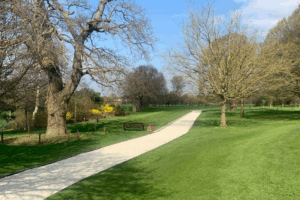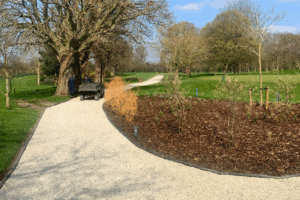Gravelrings
Gravel grid system

When Roehampton Club in Southwest London needed to upgrade the maintenance and buggy tracks for its prestigious 18-hole golf course, it trialled two different gravel retaining systems. Beauxfort’s Gravelrings emerged as the best performer after only a few days of testing, with the other grid already showing through, and the Club now boasts gravel pathways which look better and perform better than the self-binding gravel they replaced. And, crucially, they require little or no maintenance, freeing up more of the greenkeepers’ time to care for the course.
Perhaps the best known of the Roehampton Club’s many sporting facilities is its 18-hole golf course. Hosting tournaments such as the Gold Challenge Cup and the European Senior Tour Pro Am, the course also sees thousands of games played every year by its members.
The Club’s team of 12 greenkeepers, who work all-year-round to keep the course in tip-top shape, move round the course on their quad bikes via maintenance tracks. Meanwhile, the club’s members use a different set of tracks to access the course in golf buggies.
Like many golf clubs, the tracks at Roehampton were made of self-binding gravel, sometimes called hoggin, a mixture of clay, gravel and sand or granite dust that is compacted into a hard surface. One of the problems with hoggin is that it is prone to rutting and deformation, especially with heavy vehicle use, which in turn can lead to puddling during wet weather. This was an issue at Roehampton, requiring regular maintenance interventions from the greenkeeping team to keep the course in action, even in periods of poor weather.
In selecting a solution for the maintenance and buggy tracks, Roehampton Club was looking for something that would meet the high-end aesthetics of the facility while standing up to the constant passage of tyres without requiring frequent maintenance. In selecting the solution, the Club trialled two different systems, choosing Gravelrings due to its superior performance.
Over the course of 12 months, the greenkeepers installed a total of 1,600 sqm of Gravelrings, working on phased sections to minimise disruption to the Club’s members. As well as installing the grids and gravel, the team also put down a new layer of subbase to ensure the longevity of the pathways.
The new gravel pathways look fantastic and are performing as expected. Because there is no rutting and rain water drains through the gravel, muddy puddles are no longer an issue. The greenkeeping team reports that the maintenance track has even remained intact after trucks and excavators drove over them to access bunkers for maintenance activities. Previously, this heavyweight equipment would have churned up the track and carried mud onto the course.







